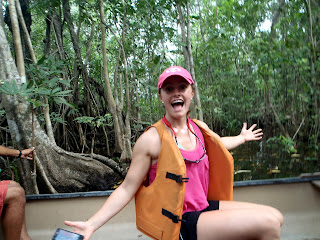There was running water (some of the time) and even
electricity if we hiked down to the Visitor’s Center while the solar panels were running. They are hoping to get more tourists to visit the area and, if they
can get the infrastructure for housing such visitors into place, it would be
well worth the trip.
We did turtle walks five nights while we were there. One night we took off and the other we could not go out to the beach because we were in the middle of an awesome monsoon. The beach we are
patrolling is about 10 km long, but we split it into two sections, patrolling one of them every other night.
We begin the walk about 8pm and returned for a few hours sleep at 11 pm.
Everyone gets up again at 2am and we again for three hours, returning to the house about 5 am. We then get to sleep until noon or so, before getting up up for breakfast.
The beach walking will take some getting adapting—let’s just
say that after this trip, long walks on the beach will be less than romantic
for a while.
We went canoeing out on Rio Salado. Salado means “salty” and the river is quite brackish. It is a beautiful river. There are Red, White, and Black Mangroves growing along the banks and a riot of other plants. It has both manatees and crocodiles, but we unfortunately did not see either of them. I have been keeping a Honduran bird list and added Boat-billed Heron, White-faced Parrot, and Anhinga to the list while canoeing. We also saw Howler Monkeys and a troop of White-faced Monkeys spent quite a bit of time hanging out above our canoes, watching us.
White-faced Monkeys and the lovely, enthusiastic Ariana
I have been keeping a Honduran bird list and added Boat-billed Heron, White-faced Parrot, and Anhinga to the list today. We also saw Howler Monkeys and a troop of White-faced Monkeys spent quite a bit of time hanging out above our canoes, watching us.
 |

Dr. D and our river guide
I keep being amazed by the huge amount of biodiversity to be
found here. Just looking out the window of my bedroom, I get two or three news
species of birds every day. Seeing animals like the Anhinga and the Basilisk
lizard (also known as the “Jesus Christ Lizard” because it can walk on water), which
I had only ever seen in movies before is really exciting.
Basilisk Lizard
It is also really sad
to know how endangered some of these animals are. The Honduras government is
very slow to start conservation projects, the existing projects are often not completed, and environmental law is rarely enforced. The turtles I am here to work with
are critically endangered, but they aren’t the only ones. We don’t even begin
to know all the incredible species that live in the forests, seas, and
mountains of this country, but they are becoming more scarce daily. There are
many groups that are working to change that and they come from all over the world, but most the motivation for change must come from inside of Honduras, where there is little willingness to put in the work to save such national treasures. Change takes time and community
support—from both the grassroots and the government level—and the support simply isn't there. Until things change, animals and plants that are vital to the beauty and health of these ecosystems will continue to disappear without a trace.








Robyn, what a treat to see all of what you are seeing!
ReplyDeleteHugs from Aunt Karen!
So jealous of your bird list!
ReplyDelete